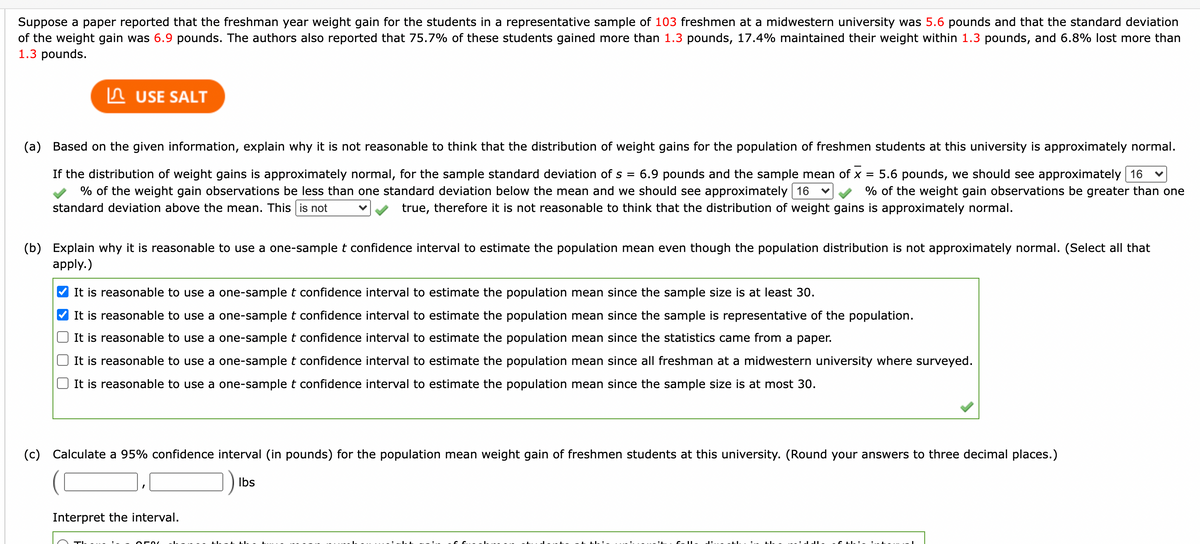Suppose a paper reported that the freshman year weight gain for the students in a representative sample of 103 freshmen at a midwestern university was 5.6 pounds and that the standard deviation of the weight gain was 6.9 pounds. The authors also reported that 75.7% of these students gained more than 1.3 pounds, 17.4% maintained their weight within 1.3 pounds, and 6.8% lost more than 1.3 pounds. C) Calculate a 95% confidence interval (in pounds) for the population mean weight gain of freshmen students at this university. (Round your answers to three decimal places.)
Suppose a paper reported that the freshman year weight gain for the students in a representative sample of 103 freshmen at a midwestern university was 5.6 pounds and that the standard deviation of the weight gain was 6.9 pounds. The authors also reported that 75.7% of these students gained more than 1.3 pounds, 17.4% maintained their weight within 1.3 pounds, and 6.8% lost more than 1.3 pounds. C) Calculate a 95% confidence interval (in pounds) for the population mean weight gain of freshmen students at this university. (Round your answers to three decimal places.)
Glencoe Algebra 1, Student Edition, 9780079039897, 0079039898, 2018
18th Edition
ISBN:9780079039897
Author:Carter
Publisher:Carter
Chapter10: Statistics
Section10.4: Distributions Of Data
Problem 19PFA
Related questions
Question
Suppose a paper reported that the freshman year weight gain for the students in a representative sample of 103 freshmen at a midwestern university was 5.6 pounds and that the standard deviation of the weight gain was 6.9 pounds. The authors also reported that 75.7% of these students gained more than 1.3 pounds, 17.4% maintained their weight within 1.3 pounds, and 6.8% lost more than 1.3 pounds.
C) Calculate a 95% confidence interval (in pounds) for the population mean weight gain of freshmen students at this university. (Round your answers to three decimal places.)

Transcribed Image Text:Suppose a paper reported that the freshman year weight gain for the students in a representative sample of 103 freshmen at a midwestern university was 5.6 pounds and that the standard deviation
of the weight gain was 6.9 pounds. The authors also reported that 75.7% of these students gained more than 1.3 pounds, 17.4% maintained their weight within 1.3 pounds, and 6.8% lost more than
1.3 pounds.
In USE SALT
(a) Based on the given information, explain why it is not reasonable to think that the distribution of weight gains for the population of freshmen students at this university is approximately normal.
If the distribution of weight gains is approximately normal, for the sample standard deviation of s = 6.9 pounds and the sample mean of x = 5.6 pounds, we should see approximately 16
% of the weight gain observations be less than one standard deviation below the mean and we should see approximately 16
standard deviation above the mean. This is not
% of the weight gain observations be greater than one
true, therefore it is not reasonable to think that the distribution of weight gains is approximately normal.
(b) Explain why it is reasonable to use a one-sample t confidence interval to estimate the population mean even though the population distribution is not approximately normal. (Select all that
apply.)
It is reasonable to use a one-sample t confidence interval to estimate the population mean since the sample size is at least 30.
It is reasonable to use a one-sample t confidence interval to estimate the population mean since the sample is representative of the population.
It is reasonable to use a one-sample t confidence interval to estimate the population mean since the statistics came from a paper.
It is reasonable to use a one-sample t confidence interval to estimate the population mean since all freshman at a midwestern university where surveyed.
It is reasonable to use a one-sample t confidence interval to estimate the population mean since the sample size is at most 30.
(c) Calculate a 95% confidence interval (in pounds) for the population mean weight gain of freshmen students at this university. (Round your answers to three decimal places.)
Ibs
Interpret the interval.
Expert Solution
This question has been solved!
Explore an expertly crafted, step-by-step solution for a thorough understanding of key concepts.
This is a popular solution!
Trending now
This is a popular solution!
Step by step
Solved in 2 steps with 1 images

Recommended textbooks for you

Glencoe Algebra 1, Student Edition, 9780079039897…
Algebra
ISBN:
9780079039897
Author:
Carter
Publisher:
McGraw Hill

Glencoe Algebra 1, Student Edition, 9780079039897…
Algebra
ISBN:
9780079039897
Author:
Carter
Publisher:
McGraw Hill